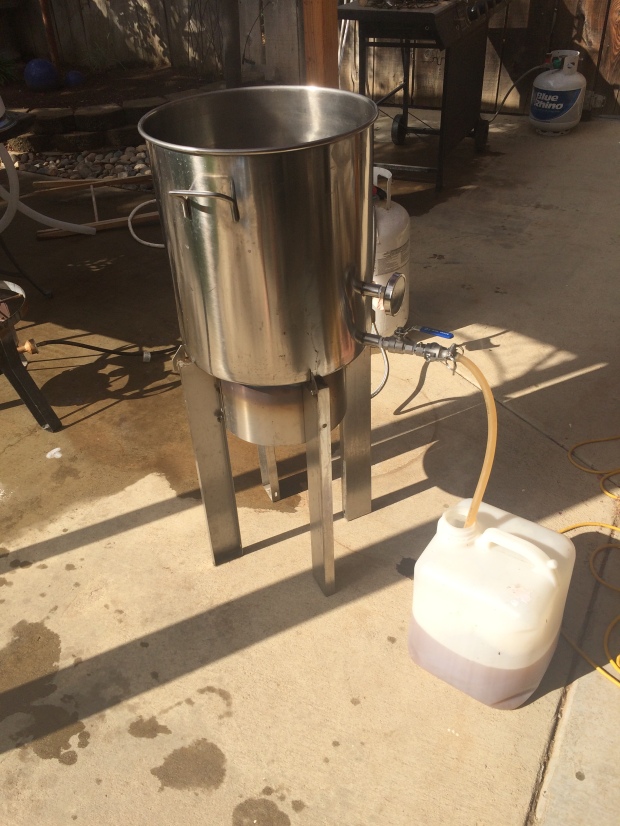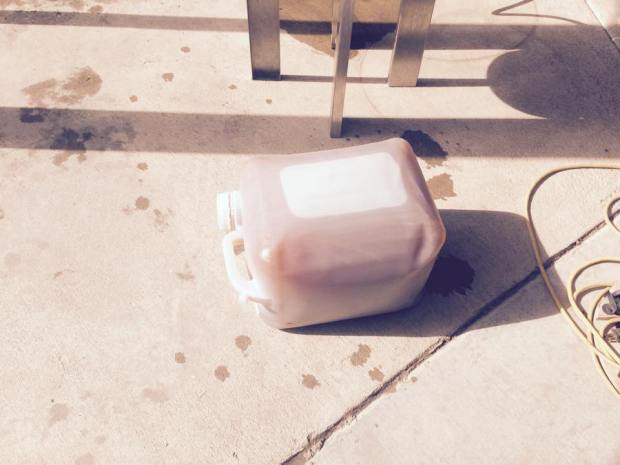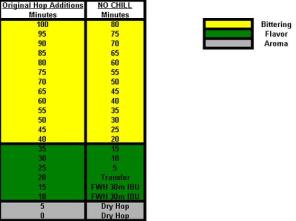THE PROCESS
Seeing that no-chill is a method for chilling wort, which happens basically at the end of the brew day, my typical brewing process didn’t much change. For this experimental year, I chose to employ both batch sparge or no sparge mash methods, the ultimate choice being recipe dependent. The boil would proceed as normal then once complete, and following any flameout hop addition rests, the near boiling temp wort was racked into a clean and sanitized HDPE cube.

Once filled, any excess air was squeezed out to ensure complete contact of the hot wort with the container walls and lid.

I would then store the cube in a relatively cool environment, either my garage or laundry room depending on outdoor temps, and allow it to chill to pitching temps overnight. The following day, the wort was poured vigorously into a fermentation vessel for aeration purposes and the yeast was pitched. At this point, the beer was placed in my temp controlled ferm chamber where standard fermentation procedures were employed.
INITIAL IMPRESSIONS
And so, I brewed my first batch of no-chill beer, an English Mild (BJCP Style 11A) slated for a local club competition. I thought this was perfect timing and was stoked that my first batch produced using this method would be tasted blind by qualified judges with zero knowledge about the process. Go figure, my Mild ended up taking 2nd in the competition with a score of 40 points. Woo! I began to feel like I was really onto something!
My next few batches were equally as successful. A Chocolate Stout and a Belgian Dubbel both came out without any off flavors that would lead me to think the process was problematic, and the time savings this allowed on brew days was really getting me excited. Like, boner excited. In fact, the brew days were so quick and easy, clocking in at less than 4 hour, that I brewed most of my batches in 2014 during the week after I got home from work (ahem… I work from home). Things were certainly looking up!
WHY SO BITTER?
Alas, not all could be as smooth as I had hoped. As summer approached and the club competition beers turned toward Pale Ale and IPA, the shortcomings of no-chill started to become apparent.
The first hoppy beer I made using this method was an iteration of Tasty McDole’s popular Janet’s Brown Ale. I completely neglected any recipe alteration to account for prolonged contact of the hops with the hot wort, an unfortunate mistake that led to a beer that  was excessively bitter and grassy with awkward mint background notes. It was a mess. My frustration with the failure of these beers came to a head when one of my best friends in brewing told me he was worried about me. Hmph. This is the point where I began revealing my little secret, as I wanted to seek advice from my brewing brethren. After evaluating the aforementioned Brown Ale, there was unanimous agreement the culprit was most likely extended contact time of the hops with the hot wort. I went on to brew an English Bitter and an Imperial IPA, both of which were equally as problematic, exhibiting off-flavors I was dubbing “hop astringency” due to the excessive grassy and minty characters that could only be attributed to this process. I also brewed the infamous Belma beer from the Brewer’s Thumbprint xBmt. As discussed in that article, while all of those beers were odd in different ways, likely as a result of a shitty recipe, the off-flavors in my no-chill batch were very pronounced. Something was amiss, I was beginning to wonder just how meritorious this method really was. Then the year came to an end, it was time to reflect and make some decisions.
was excessively bitter and grassy with awkward mint background notes. It was a mess. My frustration with the failure of these beers came to a head when one of my best friends in brewing told me he was worried about me. Hmph. This is the point where I began revealing my little secret, as I wanted to seek advice from my brewing brethren. After evaluating the aforementioned Brown Ale, there was unanimous agreement the culprit was most likely extended contact time of the hops with the hot wort. I went on to brew an English Bitter and an Imperial IPA, both of which were equally as problematic, exhibiting off-flavors I was dubbing “hop astringency” due to the excessive grassy and minty characters that could only be attributed to this process. I also brewed the infamous Belma beer from the Brewer’s Thumbprint xBmt. As discussed in that article, while all of those beers were odd in different ways, likely as a result of a shitty recipe, the off-flavors in my no-chill batch were very pronounced. Something was amiss, I was beginning to wonder just how meritorious this method really was. Then the year came to an end, it was time to reflect and make some decisions.
CONCLUSIONS
First and foremost, I’m comfortable saying that I would not recommend using this technique for very hop forward styles. The Pale Ales and IPAs I brewed simply didn’t come out very well. However, no-chill worked great for malt forward styles and never produced the off-flavors many swore it would, namely DMS presumed to be caused by not chilling fast enough. Every single beer I brewed lacked clarity and had a very unattractive haze, despite the use of Irish Moss and a good cold crash. Now, I completed this exBEERiment before learning of the greatness of fining with gelatin, which I’d guess is an effective way of achieving clearer no-chill beer, I’ll have to try this at some point. Last but most definitely not least, the risk of botulism, particularly since the yeast is pitched within 24 hours of boiling, is absolutely low enough to be of little concern to me. I’m basing this statement solely off the fact that my friends and I are still alive. That’s worth something, right?
Another thing to keep in mind is that the no-chill method doesn’t allow you to slack off with sanitation. By keeping everything clean and moving the hot wort into a sanitized cube, the likelihood of beer-ruining nasties setting up shop during the chill period is pretty damn low.